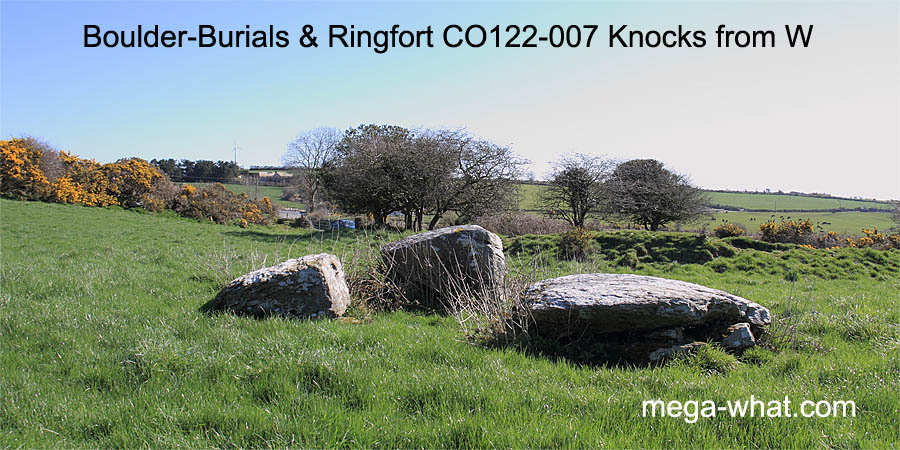 Knocks Boulder-Burials are about 6km south of Enniskean and 8km north of Clonakilty.
There are three of them, set closely together in a triangular formation beside a small ringfort, which is a later monument. Survey was from the central space.
Knocks Boulder-Burials are about 6km south of Enniskean and 8km north of Clonakilty.
There are three of them, set closely together in a triangular formation beside a small ringfort, which is a later monument. Survey was from the central space.
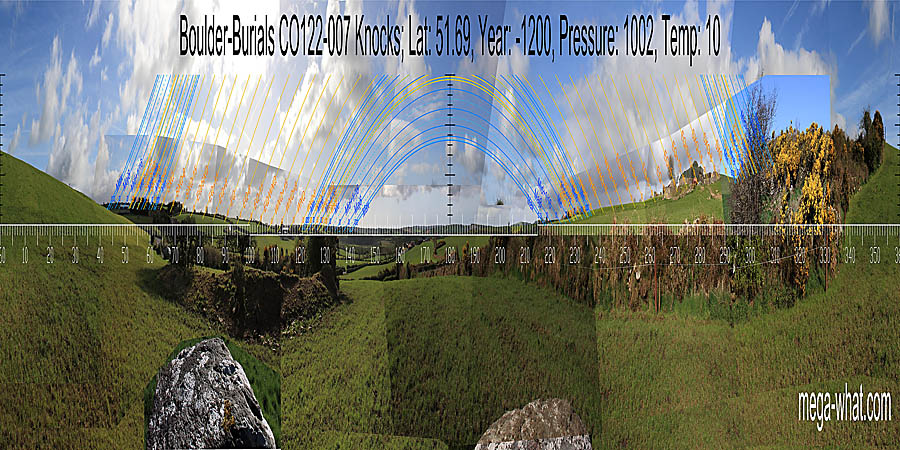 There is an approximate symmetry between highest and lowest points.
There is an approximate symmetry between highest and lowest points.
North is just to the right of a local high point from the central space, so quite possibly accurately on it from the west most boulder [Pic].
South is on the right of a dip, just to the right of the right-hand intersect of most distant and nearer horizons [Pic].
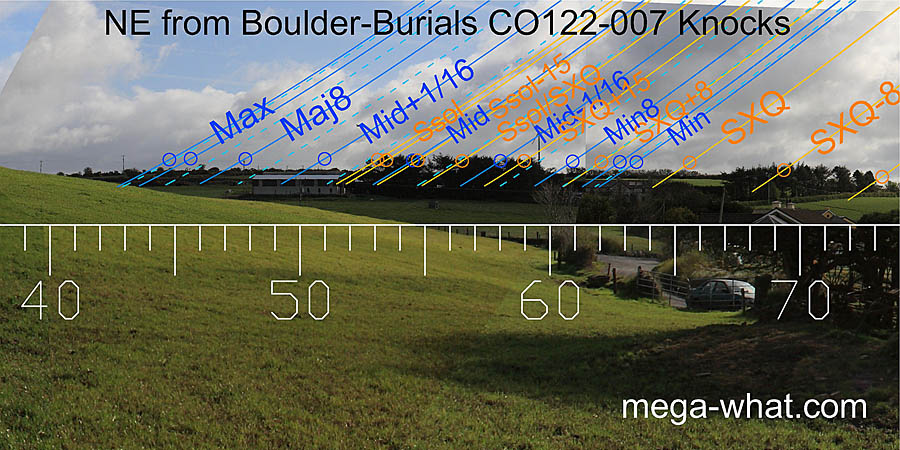 The north-eastern lunisticeLunistices are the most northerly and southerly moons of the month. The lunar equivalent of solstices - more.
zone spans a low rise and its intersect with local ground is an approximate indicator for the major standstillLunistice positions vary cyclically over an 18.6 year period but are fairly static for more than a year at either end of the range.
The north-eastern lunisticeLunistices are the most northerly and southerly moons of the month. The lunar equivalent of solstices - more.
zone spans a low rise and its intersect with local ground is an approximate indicator for the major standstillLunistice positions vary cyclically over an 18.6 year period but are fairly static for more than a year at either end of the range.
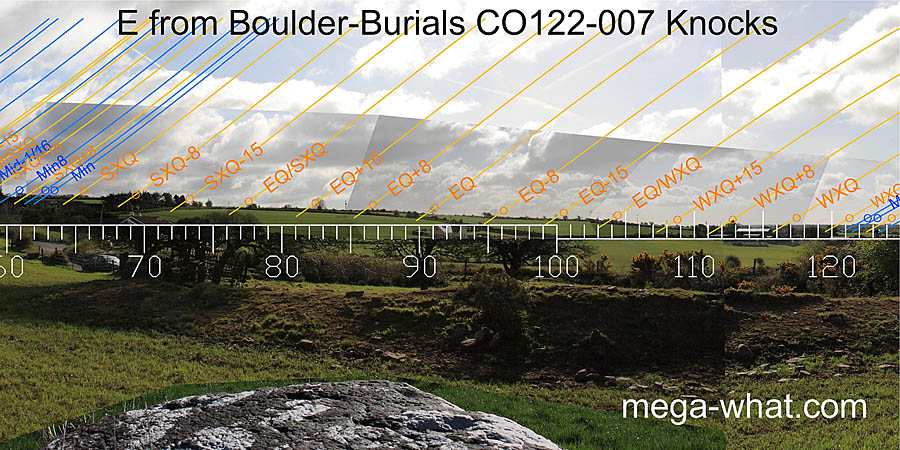 The eastern solar zone is on a gentle rising slope that is a half-month from summer cross-quarter at one end and a quarter-month from winter cross-quarter at the other.
The eastern solar zone is on a gentle rising slope that is a half-month from summer cross-quarter at one end and a quarter-month from winter cross-quarter at the other.
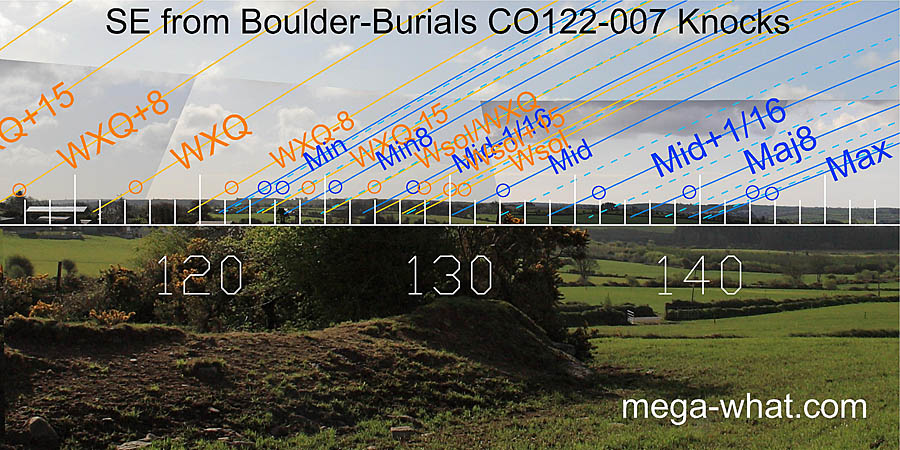 The south-eastern major standstillLunistice positions vary cyclically over an 18.6 year period but are fairly static for more than a year at either end of the range
is on a hill at Gallanes that is now crowned by a concrete resevoir but once had a large Standing Stone on its summit.
This stone (CO135-024001, 8km away) was a wide slab and may have been set there to be a visual target.
East of this, the first hilltop marks the major eighth and the dip beyond is close to the sixteenth.
The next hill intersects with nearer ground forming a notch that marks lunar midpoint.
The next dip is a half-month south of the winter cross-quarters and the notch beyond that again is a quarter-month.
The minor end of the lunisticeLunistices are the most northerly and southerly moons of the month. The lunar equivalent of solstices - more.
range is on the hill between these last two.
The south-eastern major standstillLunistice positions vary cyclically over an 18.6 year period but are fairly static for more than a year at either end of the range
is on a hill at Gallanes that is now crowned by a concrete resevoir but once had a large Standing Stone on its summit.
This stone (CO135-024001, 8km away) was a wide slab and may have been set there to be a visual target.
East of this, the first hilltop marks the major eighth and the dip beyond is close to the sixteenth.
The next hill intersects with nearer ground forming a notch that marks lunar midpoint.
The next dip is a half-month south of the winter cross-quarters and the notch beyond that again is a quarter-month.
The minor end of the lunisticeLunistices are the most northerly and southerly moons of the month. The lunar equivalent of solstices - more.
range is on the hill between these last two.
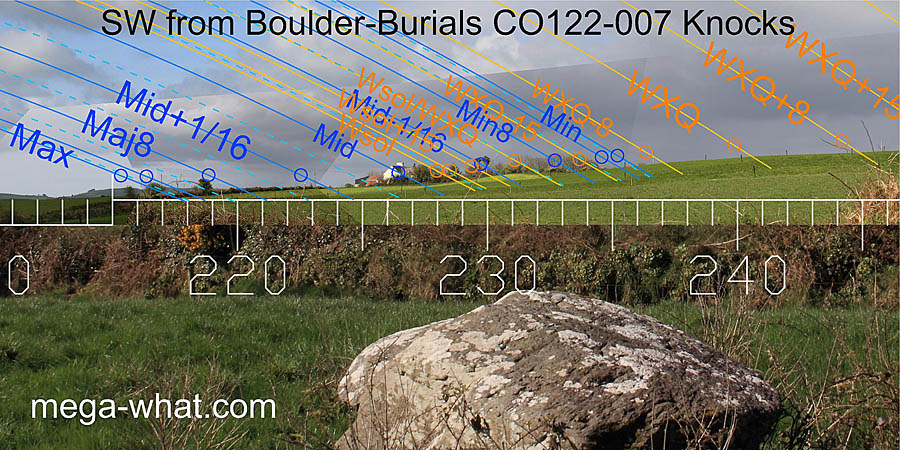 The south-western major standstillLunistice positions vary cyclically over an 18.6 year period but are fairly static for more than a year at either end of the range
is in a dip of a distant hilltop and the intersect with local ground is a major eighth.
A farm now occupies the central part of the lunisticeLunistices are the most northerly and southerly moons of the month. The lunar equivalent of solstices - more.
zone and the minor standstillLunistice positions vary cyclically over an 18.6 year period but are fairly static for more than a year at either end of the range
is just beyond it.
The south-western major standstillLunistice positions vary cyclically over an 18.6 year period but are fairly static for more than a year at either end of the range
is in a dip of a distant hilltop and the intersect with local ground is a major eighth.
A farm now occupies the central part of the lunisticeLunistices are the most northerly and southerly moons of the month. The lunar equivalent of solstices - more.
zone and the minor standstillLunistice positions vary cyclically over an 18.6 year period but are fairly static for more than a year at either end of the range
is just beyond it.
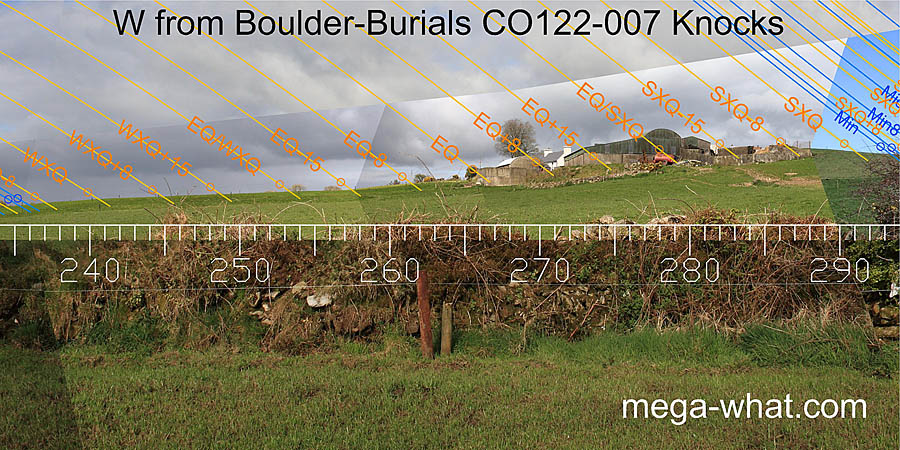 To the west is a local slope. A slight break is a half-month south of the equinox and the top is a quarter-month south of summer cross-quarter.
Between them a farm now obscures the equinoctial zone.
To the west is a local slope. A slight break is a half-month south of the equinox and the top is a quarter-month south of summer cross-quarter.
Between them a farm now obscures the equinoctial zone.
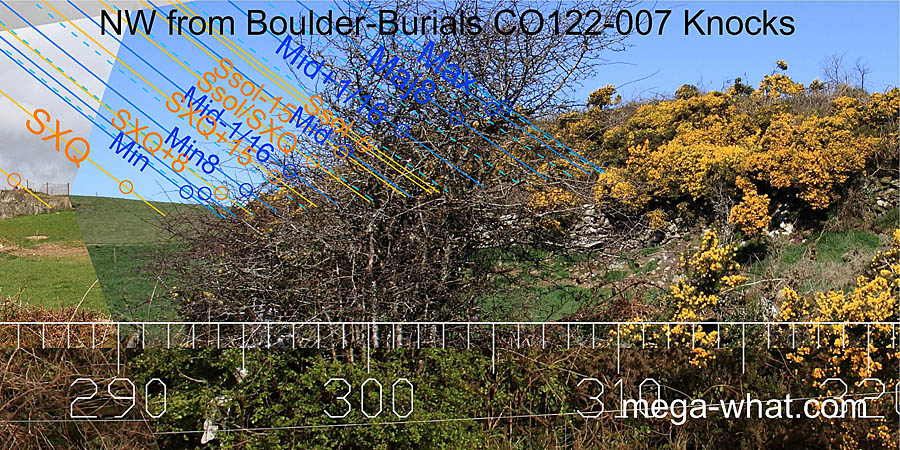 The north-west is extremely local and its intersect with the slightly more distant slope is a quarter-month north of summer cross-quarter.
That is so from the survey position in the middle of all three boulders but such a mark is obviously very sensitive to exact observer position.
The north-west is extremely local and its intersect with the slightly more distant slope is a quarter-month north of summer cross-quarter.
That is so from the survey position in the middle of all three boulders but such a mark is obviously very sensitive to exact observer position.
- Caherkirky Boulder-Burials are about 3km to the west.
- Templebryan Stone Circle is about 6.4km to the south-east.
References
- Archaeological Survey of Ireland, record details. www.archaeology.ie/archaeological-survey-ireland
- POWER, D. et al. 1992 Archaeological Inventory of County Cork, Volume 1: West Cork. Dublin: Stationary Office. p32, no.124.
